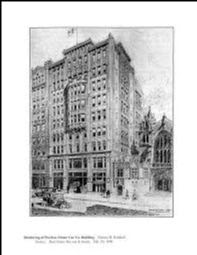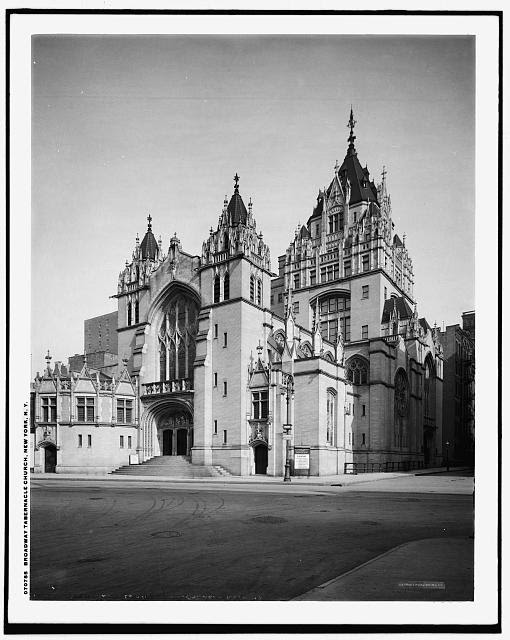Thursday, October 22, 2020 -Do you remember Car Dealer Row on 57th Street?


THURSDAY, OCTOBER 22, 2020
The
189th Edition
From Our Archives
The Peerless Motor
and Demarest Buildings
Broadway and 57th Street
FROM
Daytonian in Manhattan (c)
The stories behind the buildings, statues and other points of interest that make Manhattan fascinating.

In the first decade of the 20th century what had been the carriage-making district of Broadway from Times Square to approximately 72nd Street was becoming known as “Automobile Row.” The horseless carriage was rapidly taking over America’s roads with manufacturers cranking out around 200,000 automobiles a year. By 1910 the industry-related buildings would stretch as far as 110th Street. Among the smart carriage builders had been Demarest & Chevalier whose high-end showrooms were located in the fashionable 5th Avenue and 33rd Street neighborhood, across from the Waldorf Hotel. Around 1902 the firm cautiously began manufacturing automobile bodies as well. The elderly Aaron T. Demarest died on July 13, 1908 after having eaten tainted clams. His partner, Gabriel C. Chevalier, recognized that the age of the carriage was quickly passing away and that same year decided on a move to Automobile Row. Simultaneously the Peerless Motor Car Co. of New York, a branch of the Cleveland automobile manufacturing firm, planned its new showroom and headquarters. Peerless Motor Cars were the top of the line—luxury automobiles built for discriminating and wealthy consumers. On December 8, 1908 The New York Times reported that A. T. Demarest & Co. had leased a nine-story building—yet to be erected—on the southeast corner of Broadway and 57th Street. “The United States Realty and Improvement Company,” said the article, “will erect the building from plans by Francis H. Kimball.” The Times remarked that “Originally in the carriage building business, the Demarest concern now finds it advantageous to be north of Times Square.
Demurest signed a 20-year lease with a staggering aggregate rent of $1 million. In a somewhat “and by the way” note, article added that “An ‘L’ –shaped parcel adjoining this Broadway and Fifty-seventh Street corner was sold recently to the Peerless Motor Car Company through the same brokers.” A month later Francis H. Kimball filed plans for the new building, a “nine-story garage,” for A. T. Demarest & Co. The projected cost of the structure was $150,000. The Times remarked in February 1909 on the rapid building along what it termed the “automobile belt.” The newspaper remarked on the proposed buildings of Peerless and Demarest saying “the one to be built and owned by the future occupants, and the other controlled under a long lease that for all practical purposes amounts almost to ownership.” The automobile had changed the complexion of Broadway. The article noted that developers, a decade earlier, had other plans for the real estate, “…but at just about that time came the remarkable expansion in the automobile industry, and these Broadway concerns have become the sites, not of apartment houses, but of salesrooms and garages…To-day the automobile business has become so firmly established in this section that it is not likely to be displaced easily.” Architect Francis Kimball paid deference to the hulking Gothic-style Broadway Tabernacle adjacent to the building sites and planned both to complement it. Designing the two structures so harmoniously that they are most often mistaken for a single building, he frosted the facades with Gothic- and Romanesque-inspired motifs. Plans moved ahead in a blurring pace with construction on both structures commencing early in March 1909. Within three months the Demarest was completed, followed by the Peerless building in September. The remarkable façade, produced by the New York Architectural Terra Cotta Co., was praised by Architects’ & Builders’ Magazine.
“Carried out in white terra cotta, the Gothic treatment is suitable in keeping with the design of the church, and makes a bond between the business structure and the house of worship, which would hardly seem a possibility were it not before our eyes.”

Peerless immediately published a description of the showrooms as a reflection of its high-end product. “The salesroom occupies the ground floor, and is designed to be in keeping with the Peerless cars, in dignity and richness. The walls and columns are of Botticino marble. The panels and side walls are of Greek Skyros, and the base of Pennsylvania Serpentine marble. The border of the floor is in Verde Antique and Old Convent Sienna. The Mosaic floor is of Sienna marble sawed in slabs and broken by hand, to get a novel effect. “

In order to prevent an unwanted glare of electric lights, the lamps were concealed behind marble caps to diffuse the light. The entire ceiling of the showroom was gold leafed. Two huge elevators moved automobiles between floors and a turntable at the 57th Street entrance easily changed the direction of the cars.

A Peerless automobile leaves the 57th Street entrance in 1910 — from The New York Home of the Peerless (copyright expired) Unlike its neighbor, Demarest & Co. did not manufacture complete automobiles, but luxury car bodies. In 1911 The New York Times reported on the luxurious and colorful bodies being shown. “Demarest & Co. will place the 38 horsepower English Daimler Silent Knight show chassis in the space this morning. The other cars they are displaying are three Italas and three Renaults. All the bodies having been built in their own shops. One Itala is a 30 horse power with a green limousine body, another is a 20 horse power show chassis, and the third is a 15 horse power dark blue folding front landaulet. “The Renaults shown in the Demarest space are a 12-16 horse maroon extension front landaulet, with one-fourth windows at each side in front; a 14-20 horse power green landaulet, with a detachable top over the driver’s seat and folding window pillars arranged so the body can be changed into an open one for touring, and a 20-30 horse power maroon limousine.”
PHOTO ABOVE
To emphasize the exclusive nature of the Peerless automobile, the company would often advertise it parked in front of a mansion or other high-end setting, as in this 1909 ad — NYPL Collection

Around 1915 Peerless Motor Car left its L-shaped building and two years later A. T. Demarest & Co. did the same. In May 1917 Chevrolet Motor Co. of New York leased the Demarest building, only to purchase it the following year. Chevrolet became a division of General Motors that year, in 1918, transferred the property to GM. Almost simultaneously, General Motors purchased the Peerless building next door. Architect Henry J. Hardenbergh was commissioned to combine the two buildings into one. While the exterior remained unchanged, the two structures became the headquarters of General Motors Corporation. Although GM erected another headquarters building in Detroit in 1922, it retained the 57th Street building as its New York headquarters until 1927. The street level showrooms continued to be used to showcase its many makes—Cadillac, LaSalle, Chevrolet and Pontiac among them—until the early 1970s.
THURSDAY PHOTO OF THE DAY
SEND ENTRY TO ROOSEVELTISLANDHISTORY@GMAIL.COM
TRINKET FROM KIOSK FOR FIRST PRIZE WINNER

WEDNESDAY PHOTO OF THE DAY
OOPS WE DID NOT GET YOUR E-MAILS DUE TO A SPELLING
ERROR. OUR E-MAIL IS:
ROOSEVELTISLANDHISTORY@GMAIL.COM
SEND YOUR SUBMISSIONS AGAIN PLEASE!

MEMORIES

Your photo of the Erector Set in the RIHS newsletter today reminder me of the many hours of pleasure I got from building objects with my Erector Sets (I had several). I thought you might be interested in the attached photo of me (c. 13 yrs. Old) looking with pride of my just completed parachute jump—the ultimate Erector Set construction. IVAN STEEN is a professor at SUNY Albany and historian on UDC, Ed Logue and the development of Roosevelt Island.
Now this one sure did bring back memories. Every one of these toys were in our home in Kearny, NJ when we 4 were little. And although I couldn’t play with my train set I still have that set here in my apartment. My erector set was a special gift from my grandmother. My sisters had the kitchen cabinets with china dishes. Chinese checkers. Candy Land. Monopoly…we had it all. Pin the tail on the donkey…put it up on a door with tape. Memories. Bill Weiss
EDITORIAL

From DNA INFO:
“The Sunbather,” a 4,000-pound bronze work by artist Ohad Meromi, was installed on a traffic median at the intersection of 43rd Avenue and Jackson Avenue.
A controversial bright pink sculpture that drew criticism for its color and $515,000 price tag now has a permanent place on Jackson Avenue. “The Sunbather,” a 4,000-pound bronze work by artist Ohad Meromi, was installed over the weekend on a traffic median at the intersection of 43rd Avenue, according to city officials.
The bubble-gum pink sculpture, which the city calls an “instant icon for the Long Island City neighborhood,” stands more than 8 feet tall and 10 feet wide, and depicts a reclining human figure described by the artist as a “generalized body at rest.”
Paid for with funding from a street improvement project completed in 2010, the sculpture was commissioned under the Department of Cultural Affairs’ Percent for Art program, which uses one percent of the budget from certain city construction projects for public art.
But plans for the work were initially met with some online criticism, particularly about the sculpture’s color. Someone erected their own wooden sculpture on Jackson Avenue, with a sign calling The Sunbather’s $515,000 budget a “misuse of our tax dollars.” The controversy over the piece prompted City Councilman Jimmy Van Bramer to introduce a bill that would require more public input on Percent for Art projects.
In a statement sent out Monday, Cultural Affairs Commissioner Tom Finkelpearl praised the work. “Public art is so important to New York City,” he said. “Whether it’s joyous or somber, large or small, traditional sculpture or an innovative, interactive work, public art has the power to enhance our civic space and make us see our city with new eyes.”
As I passed by this morning and was shocked to see the work of art in the middle of the street. My personal opinion was that it looked like papier mache work we did as kids wrapping the paper around clothes hangers,
That is my opinion and I am glad not to have to pass by this object often.
Judith Berdy
CLARIFICATION
WE ARE HAPPY TO GIVE WINNERS OF OUR DAILY PHOTO IDENTIFICATION A TRINKET FROM THE VISITOR CENTER.
ONLY THE PERSON IDENTIFYING THE PHOTO FIRST WILL GET A PRIZE. WE HAVE
A SPECIAL GROUP OF ITEMS TO CHOOSE FROM. WE CANNOT GIVE AWAY ALL OUR ITEMS,.
PLEASE UNDERSTAND THAT IN THESE DIFFICULT TIMES, WE MUST LIMIT GIVE-AWAYS. THANK YOU
Text by Judith Berdy
Thanks to Bobbie Slonevsky for her dedication to Blackwell’s Almanac and the RIHS
Thanks to Deborah Dorff for maintaining our website
Edited by Melanie Colter and Deborah Dorff
All image are copyrighted (c)
A DAYTONIAN IN MANHATTAN (C)
FUNDING PROVIDED BY ROOSEVELT ISLAND OPERATING CORPORATION PUBLIC PURPOSE GRANTS CITY COUNCIL REPRESENTATIVE BEN KALLOS DISCRETIONARY FUNDING THRU DYCD


Copyright © 2020 Roosevelt Island Historical Society, All rights reserved.
Our mailing address is:
rooseveltislandhistory@gmail.com



Leave a comment